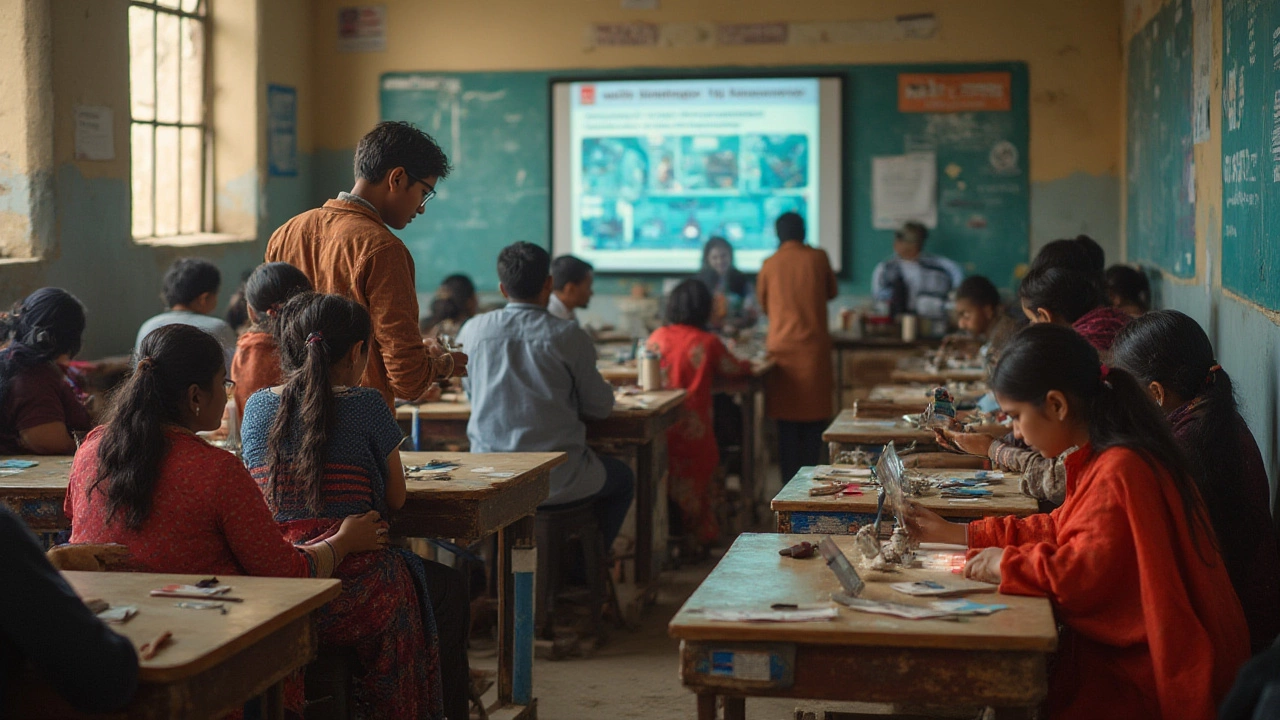
Imagine this: a young mother in a small town, balancing family life, suddenly mastering computer basics through a short course. Months later, she's running her small business’s accounts. Or consider a teenager uninterested in textbooks but who, after a hands-on plumbing program, lands a stable job within a year. Vocational training isn’t about theory; it’s about transforming real people’s lives with usable skills—quickly and directly. Forget the image of dreary classrooms; think welding workshops, bustling beauty parlors, or smart computer labs. More than 80% of Indian technical graduates and half of US trade students now report immediate job offers after finishing their practical, skill-heavy courses.
What Is Vocational Training and How Is It Different?
Let’s clear up a common mix-up. Vocational training isn’t like traditional schooling. It’s not about essays, memorizing dates, or sitting through two-hour lectures on philosophy. Instead, vocational programs focus on specific jobs—electricians, plumbers, nursing assistants, automotive technicians, digital marketers, photographers, hotel managers, fitters, tailors, and so on. The curriculum is hands-on, and everything you learn comes back to real-world tasks you’ll do on the job.
Unlike a university degree, where you might spend years in academic halls, a vocational course can range from a few months to two years. The goal is to make you employable fast. Here’s what stands out: vocational classes simulate the actual work environment. So, a welder will be working on real metal pieces. A nurse’s aide will practice bedside care in hospital setups. Colleges or training institutes usually partner with local businesses to offer internships or apprenticeships for on-the-job learning. Many countries have government-regulated bodies that certify these programs—like the NSDC in India or community colleges in the US.
This practical approach means you don’t just study what might be useful someday. You master what actually matters right now. For students from low-income backgrounds, this type of learning boosts earning power and breaks the cycle of unemployment or underemployment.
If you’re wondering about costs, they’re usually much lower than a traditional four-year degree. Many countries subsidize programs, provide scholarships for women and minorities, or offer pay-as-you-learn options. In Germany, famous for its dual education system, over 50% of high school students opt for vocational programs, working part-time and studying part-time, mixing theory and daily work. The payoff? Germany’s youth unemployment rate stays one of the lowest in the world.
Certificates earned from vocational programs are recognized across industries and often lead to licenses or credentials needed for specialized work. Some even count toward further education, so you aren’t stuck in one field if you want to switch.
Why Vocational Work Matters Right Now
There’s a myth that only top college degrees equal stable jobs. But let’s get real: countries face massive skilled labor shortages. Whether it’s construction, healthcare, IT, or even green-tech jobs, employers are desperate for people who know their stuff. The World Economic Forum reported that 73 million global jobs could go unfilled in the next five years without enough skilled workers. India alone aims to skill 400 million people by 2025 because industries from hospitality to renewable energy can’t keep up with growth.
Table: Percentage of Employers Facing Skilled Worker Shortages (2024)
| Country | Shortage (%) |
|---|---|
| Germany | 45% |
| USA | 38% |
| India | 47% |
| Japan | 60% |
This isn’t just about jobs for youth. Automation displaces workers, but also demands new technical skills. For example, a recent survey of Indian construction firms found that workers with vocational certification earned 25% more on average than untrained peers. Women especially benefit: when trained for digital or craft-based trades, they quickly move from unpaid household labor to full-time salaries.
Take a closer look at industries like healthcare, manufacturing, automotive repair, and green energy. Hospitals need nursing assistants and lab techs. Factories need millwrights and quality inspectors. Car brands require mechanics trained for hybrid engines. Solar companies are hiring certified technicians for installation and maintenance. Vocational courses fill in these market gaps fast. And some successful entrepreneurs started as certified technicians, only later launching their own companies with the skills and confidence gained from training.
Here’s a practical tip if you’re eyeing the job market—look for jobs labeled “skilled trade,” “technician,” or “operator.” If employers list “vocational certificate preferred,” you’re on the right track. And don’t overlook the earnings. A master electrician in Canada can earn as much as a college professor, without ever sitting through a four-year degree.

The Structure of a Typical Vocational Training Program
Curious about how it all fits together? Most vocational programs are carefully designed around three pillars: theory (just enough to understand the work), practical workshops, and direct workplace learning.
- Classroom theory: Usually 10-20% of the program. Covers safety basics, standards, regulations, and foundational theories. No rote learning; content is often visual or interactive.
- Hands-on workshops: The heart of the program—practicing real tasks using industry-standard equipment. May include role play (like handling customers in hotel management), simulated emergencies (nursing), or actual construction projects (masonry).
- Apprenticeship or internship: 20-50% of time—working with an experienced mentor on customer sites, shops, factories, or labs. This is where real job habits kick in: punctuality, teamwork, problem-solving under actual deadlines.
Programs usually run 3 to 24 months. Short courses might be just 6 weeks (say, computer basics or beautician entry-level), while advanced electrician or automotive diplomas last two years. Classes run daytime or weekends, and now many offer online modules so working people can join after hours.
Grading isn’t about written tests. Instructors use practical demonstrations: Can you fix the tap leak? Wire up a socket? Diagnose an engine problem? Even customer service skills get assessed through roleplay with simulated clients.
Certification comes from national or sector skill councils. For example, the National Skill Development Corporation (NSDC) in India, or the City & Guilds in the UK. Their seal on a certificate makes employers pay attention. You can check their lists online to find authorized training centers near you.
Some programs go further, training you in resume writing, interviews, and soft skills. A study in 2024 found that graduates with interview prep modules landed jobs 34% quicker than those without. If you already work, evening vocational courses offer upskilling—a plumber, for example, learning solar panel installation, stepping into the green economy.
How to Get Started: Steps to a New Skill Set
Ready to jump in? Here’s how you start:
- Identify what interests you. Ask: “Do I want to work indoors or outdoors? With people, or with things? Tech or craft?”
- Check local and online vocational schools for course offerings. Look for institutions with strong placement records and links to companies.
- Verify certificates: Make sure the school’s certificate is recognized by your country’s main training bodies—like NCVT, NSDC, City & Guilds, CompTIA.
- Apply online or offline. Some programs require an entrance test; most only need a 10th or 12th-grade pass. Women, minorities, or people with special needs may have reserved seats or extra scholarships.
- Attend an orientation if offered—this sets expectations and helps you meet trainers and batchmates. You’ll even get to try out equipment on day one in most places.
- Use any available support—free toolkits, uniforms, stipends, or travel passes. Good institutes want you to succeed and stay till the end.
- Complete the modules, pass demonstrated skills assessments, and take the placement workshops seriously.
Be open to internships. Even unpaid stints in established firms make your resume stand out. And don’t skip on-campus job fairs or the school’s alumni network for leads—all the best jobs circle through word of mouth. Stay active online: LinkedIn, Skill India, local Facebook jobs groups are gold mines for openings, especially if you’re certified.
Tip: Keep your certificate copies scanned and handy—digital portfolios impress hiring teams, and let you apply fast.
Another insider move: join industry associations, even as a trainee. These groups often post job ads before they hit public portals and can get you invited to local trade events or competitions. Prize-winners at skill contests often bag job offers on the spot.

Trends Shaping the Future of Vocational Work
The old stereotype of vocational jobs as “backup plans” is fading. Now, even graduates of engineering and business schools are signing up for short vocational courses to round out their skills. Post-pandemic, the trend is: practical wins over paper credentials.
Here’s the big shift: technology is invading every trade. Today’s automotive mechanic handles diagnostics on tablets. Construction workers use drones to inspect tall buildings. Beauticians need social media skills to attract customers. Vocational courses keep updating—sometimes every six months—to match what’s hot in industry. Short, “stackable” certificates (like data entry, digital marketing, or robotics basics) let you keep adding layers as your job evolves.
The UN’s Future of Work project estimates that half of today’s jobs will change by 2030, but people with blended skills—strong technical know-how plus digital savvy—are less likely to be replaced by robots. The best vocational programs now add modules on communication, teamwork, and digital basics, prepping students for evolving roles. A 2025 survey among Indian and Southeast Asian training graduates showed 72% used at least one hybrid digital-vocational skill in their current jobs—far higher than five years ago.
Interest is exploding among women and rural youth, groups once locked out of formal jobs. New government policies—like India’s Skill India mission or the US’s community college expansion—add thousands of new centers each year. Mobile training vans now deliver workshops to villages and urban slums, giving people access to hospitality, construction, or computer skills right at their doorstep.
A final trend: freelancing. Many tradespeople now set up as independent contractors. After finishing a course in graphic design, photography, beauty, or digital marketing, students use Instagram and WhatsApp to land clients—no boss needed. Even traditional vocational jobs, like plumbing or electrical repair, now have online booking apps matching customers with certified workers.
If you want steady work, flexible hours, or the option to start your own business, vocational training is no second-best route. For countless people, it’s the only path that makes real dreams happen.
